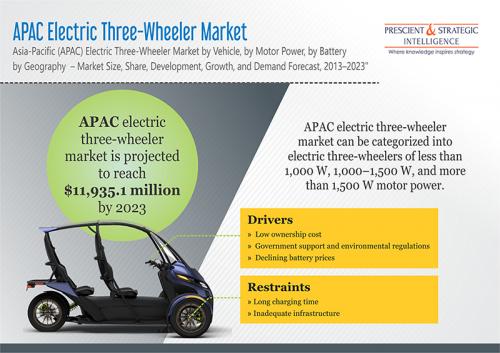Asia Electric Three-Wheeler Market Overview, Size and Share 2017–2023

The APAC
electric three-wheeler market is projected to reach $11,935.1 million
by 2023, according to P&S Intelligence.
The growth of the market is predominantly driven by the low ownership cost
of electric three-wheelers, falling battery prices, and favourable government
policies and support.
Insights into market segments
On the basis of vehicle, the APAC electric three-wheeler market can be
classified into passenger carrier and load carrier. The passenger carrier
category recorded higher sales between the two and is expected to continue
being the leading category in the market during the forecast period, much of
which can be owed to the demand for low-cost shared mobility and the presence
of large consumer base in the region. However, it is the load carrier category
that is expected to grow faster during the forecast period, owing to the
growing e-commerce industry and low operational cost of electric load carrier
as compared to the conventional fuel-based load carrier.
Request to Get the Sample Report@ https://www.psmarketresearch.com/market-analysis/apac-electric-three-wheeler-market/report-sample
Based on the motor power, the APAC electric three-wheeler market can be
categorized into electric three-wheelers of less than 1,000 W, 1,000–1,500 W,
and more than 1,500 W motor power. Electric three-wheelers with motor power
lying in the range 1,000–1,500 W dominated the market in terms of sales volume
in 2017, as it held a market share of over 50%. Also, in the APAC region,
majority of the electric three-wheelers come equipped with the motors lying in
the range 1,000–1,500 W due to their operational cost benefits. However,
because of the growing demand for high-speed electric three-wheelers and entry
of conventional fuel-based three-wheeler manufacturers into the electric
three-wheeler market, the market for electric three-wheelers equipped with
higher motor power is poised to grow during the forecast period.
The battery-powered electric three-wheelers are cost effective as compared
to their conventional gasoline-based three-wheelers. It is so because the
electric three-wheelers use stored electric charge as the fuel, which costs
lesser than the gasoline (price per kilometer). The operational cost of
electric three-wheeler is approximately six times lesser than a gasoline and
diesel counterpart.
The fuel stations required for the conventional petrol/diesel-based three-wheelers
are there in an adequate number as compared to the battery-powered electric
three-wheelers. At present, the charging infrastructure growth for electric
three-wheelers is poor in many Asian countries such as India and Bangladesh.
Much of which can be attributed to the lack of proper guidelines for state-run
agencies which are responsible for floating the tenders for charging stations.
Some of the key manufacturers in the APAC electric three-wheeler market are
Terra Motors Corporation, Xianghe Qiangsheng Electric Tricycle Factory, Jiangsu
Kingbon Vehicle Co. Ltd., Changzhou Yufeng Vehicle Co. Ltd., Kinetic Green
Energy & Power Solutions Ltd., Jiangsu East Yonsland Vehicle Manufacturing
Co. Ltd., ATUL Auto Ltd., and Lohia Auto Industries.
Post Your Ad Here
Comments